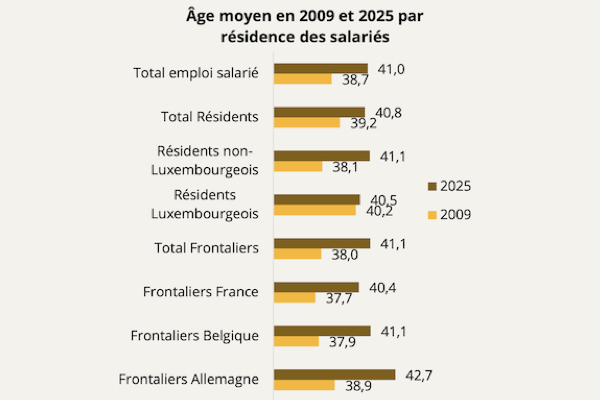 Average age in 2009 and 2025 by employee residence;
Credit: Luxembourg's Ministry of Health and Social Security and the General Inspectorate of Social Security (IGSS)
Average age in 2009 and 2025 by employee residence;
Credit: Luxembourg's Ministry of Health and Social Security and the General Inspectorate of Social Security (IGSS)
According to Fondation IDEA Asbl, the ageing of the workforce in Luxembourg has become central to discussions about employment policy, retirement planning and long-term workforce sustainability.
In a report published on Tuesday 18 November 2025, IDEA said that while the country benefits from strong immigration and a large pool of cross-border workers, which have historically helped offset the impact of population ageing, the composition of the workforce is gradually shifting towards older employees, forcing policymakers and businesses to pay close attention to these trends to ensure that labour supply remains sufficient and that knowledge and skills are effectively transferred across generations.
According to STATEC data, the average age of residents in employment in Luxembourg increased modestly from 39.8 years in 2009 to 40.4 years in 2024, reflecting a relatively slow ageing process compared with neighbouring countries such as Germany (42.4 years), Belgium (41.8 years) and France (41.7 years). When cross-border employees are included, the average age of the total workforce rose from 38.7 years in 2009 to 41 years in 2025, signalling a gradual ageing trend across the broader labour market. Notably, the number of employees aged 55–64 nearly tripled from 22,480 to 66,320, while workers under 30 increased by only 18%, rising from 71,550 to 84,580, highlighting a shift in workforce demographics. IDEA said this trend reflects both longer working lives and a higher proportion of older employees remaining in post, reinforcing the need for policies that support active ageing and senior employment.
IDEA highlighted that long-term projections suggest that senior participation in the workforce will continue to increase steadily. The activity rate of 55 to 59-year-olds is expected to rise from 65% in 2024 to 70% in 2070, while the rate for those aged 60 to 64-years old is projected to grow from 26% to 33%, driven in part by delayed retirement and changing employment patterns. Cross-border employees contributed 51% of the increase in senior employees, with non-resident workers adding 26%, indicating that migration flows continue to influence age dynamics. IDEA said this demographic shift has implications for social security contributions, skill retention and intergenerational workforce planning, making it essential to consider both resident and cross-border populations when analysing employment trends in Luxembourg.
In relation to sectoral differences, in 2025, the youngest sectors were specialised, scientific and technical activities (38 years) and HORECA (39.6 years), reflecting the recruitment of younger employees and the dynamic nature of these industries. Older sectors included manufacturing (42.3 years), transport and storage (42.5 years), construction (42.7 years) and real estate (43.1 years), where workforce ageing is more pronounced due to slower renewal and a higher proportion of long-tenured employees. Finance and insurance, HORECA, construction and ICT sectors saw the greatest increases in average age, rising 2.9 to 3.8 years since 2009, which IDEA said demonstrated how sector-specific dynamics, workforce size and recruitment patterns contributed to broader ageing trends.
IDEA said that the ratio of young employees (25 to 34) to seniors (55 to 64) fell from 4.28 in 2009 to 1.95 in 2025, highlighted the diminishing proportion of younger workers relative to older employees and the potential difficulty in maintaining an adequate supply of skilled labour. The administration sector was the only area to see a slight increase in this ratio, reflecting recent recruitment drives that have helped introduce younger staff. Declining renewal rates in other sectors underscore the importance of targeted training, apprenticeship programmes, and retention strategies to ensure that knowledge and expertise are transferred effectively across age groups.
The foundation also noted that cross-border dynamics amplified workforce ageing. According to the data, the average age of cross-border employees has risen faster than that of resident employees, reaching 41 years in 2025 and cross-border workers now represent 46% of Luxembourg’s total workforce, making them a significant factor in the ageing trend. German cross-border workers experienced the largest increase in average age (+4 years), followed by Belgian (+3.2 years) and French (+2.7 years) employees. IDEA stated that many of these workers remain in the Luxembourg labour market for long periods, contributing to both stability and demographic ageing. These patterns also reflected the attractiveness of Luxembourg for experienced workers from neighbouring regions and the challenge of attracting younger entrants to maintain workforce balance.
In relation to retirement patterns, non-resident employees tend to retire later than residents (61.8 years vs 60.6 years), while approximately a third of residents continue working beyond the age at which they qualify for early pension benefits. This contributes to the higher average age observed among non-Luxembourg employees and cross-border workers, while also highlighting the importance of flexible retirement policies and incentives for continued employment. IDEA said that differences in retirement age, combined with slower inflows of younger workers, could intensify workforce ageing over the coming decades and present challenges for labour market renewal and social security systems.
In conclusion, IDEA said: “While Luxembourg’s workforce remains younger than those of neighbouring countries, slow ageing, sectoral disparities and reliance on cross-border employment are gradually shifting the age structure. Policymakers and employers must monitor these trends closely, balancing recruitment, retention and training to ensure that Luxembourg’s labour market remains dynamic, resilient and sustainable in the decades ahead.”








